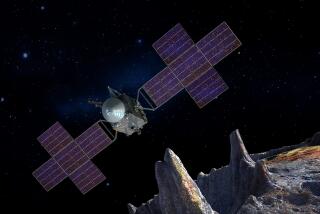Mars Surveyor Mission Nears Critical Orbit
- Share via
Nearing a critical rendezvous with Mars this week, NASA flight engineers readied themselves for a two-year mapping mission that will bring the Red Planet into dramatic focus, opening the way for almost continuous exploration of the chill and dusty body over the next decade.
Arriving on the heels of NASA’s successful Pathfinder mission, the Global Surveyor spacecraft now approaching Mars at 11,000 mph will be the first U.S. probe to systematically orbit Mars in 20 years. It is the vanguard of a virtual invasion of Mars, with the United States planning two missions to the planet every 26 months until 2005.
The $250-million Surveyor mission, scheduled to intercept Mars on Thursday, is expected to map the Martian terrain in unprecedented detail, from a volcano the size of Arizona to the deepest and longest valley known in the solar system. National Aeronautics and Space Administration scientists said they expect the mission to clarify the search for traces of past or present life on Mars and dispel popular myths, such as the persistent belief that there are mysterious face-like formations on the planet.
“We certainly expect the mission to feed the fires of scientific debates and we hope it will put to rest some long-standing controversies,” said project scientist Arden L. Albee at Caltech.
“A number of us have been waiting for this week for almost 20 years,” Albee said.
In a first step toward the Thursday rendezvous, mission engineers at the Jet Propulsion Laboratory on Tuesday revived the probe’s dormant engine, avoiding a repeat of the engineering calamity that destroyed a $980-million probe as it approached Mars in 1993.
As engineers completed a critical fuel pressurization procedure early Tuesday--the same operation implicated in the disappearance of the Mars Observer probe four years ago--the release of tension at JPL was palpable.
“That was a nail-biting thing,” said Glenn E. Cunningham, the Mars Global Surveyor project manager. “To see this event past us successfully today is really a great relief.
“The spacecraft is in really good health,” he said.
Cunningham, who also managed the earlier Mars Observer probe that vanished as it prepared to orbit Mars, called the Global Surveyor a “comeback” mission. Indeed, the spacecraft was cobbled from spare parts left over from the doomed probe, and much of its mapping mission was originally scheduled for the Observer spacecraft.
Since its launch in November, the Global Surveyor has traveled more than 435 million miles--almost halfway around the solar system--and when it intercepts Mars on Thursday night, it will skim in over the planet’s north pole.
Beginning at 6:31 p.m. PDT Thursday, Surveyor’s rockets will fire for 22 minutes, slowing it by about 2,000 mph and easing it into a long, lopsided orbit.
Then, over the course of the next four months, the spacecraft gradually will slow down and make its orbit more circular by skipping in and out of the planet’s atmosphere in a maneuver called aero-braking, a fuel-saving technique first demonstrated in 1993 during the Magellan mission to Venus.
The probe will flare its solar panels at an angle in what mission engineers call “badminton shuttlecock mode,” and for about 15 minutes during each of about 400 orbits during the four-month period, the panels will catch the imperceptible Martian atmosphere like sails. That will generate enough drag to settle the spacecraft into a nearly circular orbit about 234 miles above the planet.
“Like getting into a Jacuzzi, we’ll do it a little bit at a time,” said Joseph G. Beerer, flight operations manager at JPL for the Surveyor project.
NASA mission engineers will be keeping an especially wary eye on the vast dust storms so common on Mars between February and August. A severe storm could increase the amount of high-altitude dust the spacecraft must fly through by a factor of 10--enough to cause the probe to burn up from the additional friction.
The Hubble Space Telescope will keep an eye on Martian weather throughout the maneuver. At the first sign of a large dust storm, mission engineers plan to move the spacecraft to the safety of a higher altitude.
As it moves into its final orbit, NASA scientists first expect the probe to establish whether Mars has a planetary magnetic field.
“Despite all the missions to Mars, we do not know very much about its magnetic field,” Albee said. “If it exists at all, it is very small.”
The probe will actually start mapping on March 15, while using other instruments to glean new information about the planet’s atmosphere and surface minerals, rocks and ice.
NASA researchers expect their data trove over the next two years to exceed 700 billion bits of computerized information--more than all of the previous Mars missions combined. It is the sheer comprehensive nature of the mission that has scientists excited.
“It is not that we expect to make outstanding discoveries, but that we will achieve a global understanding of Mars,” said Albee. “This mission will provide a remarkable data set with which to guide the future exploration of Mars.”
(BEGIN TEXT OF INFOBOX / INFOGRAPHIC)
Putting on the Brakes
The Mars Global Surveyor spacecraft on Tuesday completed an important first step in a months-long procedure to slow it down into a circular orbit. If all goes well, the probe will begin mapping the planet’s terrain by mid-January.
Thursday: Surveyer expected to enter initial eliptical orbit around Mars.
Next four months: Spacecraft will skip in and out of the planet’s atmosphere, a fuel-saving braking technique that will gradually tighten its orbit.
Initial Orbit: This Thursday
Source: NASA






